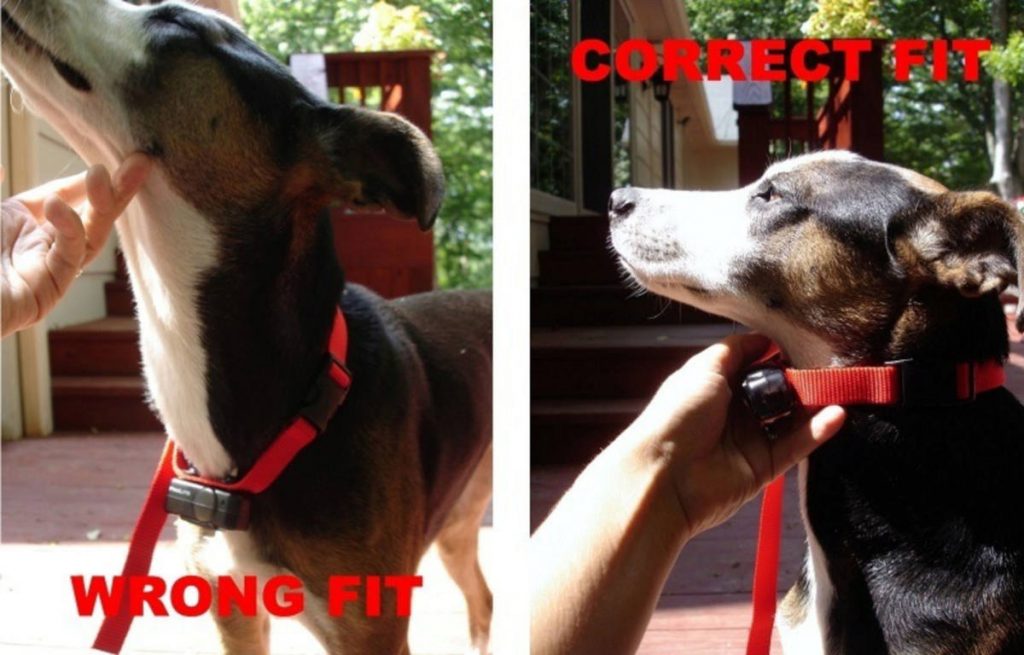Is your dog breaking through the fence?
If your dog is breaking through the fence, there are several reasons that this could be happening. Let’s take a look at what may cause this.
Proper Training
Most people already know this, but you can’t just put on your dog fence collar and expect the dog to know what it is all about. You must spend a week or two training your dog to respect the fence. Here is a link to training instructions. How long did you spend training your dog? If training was only for a day or two, the dog needs more reinforcement and retraining on a leash.
Proper Collar Fit
Take a look at the pictures below:

If your dog’s collar is able to spin around the neck freely, it is too loose. The collar should never hang down. You should only be able to get one finger between the contact points and the dog’s neck. With that being said, be cautious that the collar isn’t overtightened either. Proper collar fit is imperative. A collar that is too tight or too loose can cause a condition called pressure necrosis, which you can read about here.
Contact Points
It is imperative that the contact points are making direct contact with the skin. Your kit should have come with a set of short prongs, and a set of long prongs. Short prongs can be used on dogs with short hair, and the longer ones should be used on dogs who have longer or thicker hair. Consider the breed of dog that you have and the thickness of his coat. It may be a good idea to trim down the hair underneath the contact points. A touch of Vaseline may also be helpful, to mat down the fur a bit.
Correction Level
What correction level do you have your collar set to? Is it set to the highest level?
Keep this in mind. If you have the active collar (red and blue), the strongest level is a level 5. Levels 6 and 7 are progressive. Although your transmitter will go to the number 8, the active collar does not have a level 8. If you try and set it to a level 8, your dog will not receive a correction.
If you have the hyper collar, (all blue) the strongest level is a 5, or you could go with a progressive setting of 8.
Boundary Zone Width
The boundary zone width refers to how close the dog gets to the wire before the beep/correction happens. Is your collar beeping at all before the wire? The default setting on your eXtreme transmitter is set at 10. This number does not translate into feet. You will need to walk toward your wire with your collar in hand, to see how many feet away from your wire that the collar starts to beep.
If you don’t hear a beep at all, your boundary zone width may be set too low. Use the scroll button to increase your boundary zone width. What does this have to do with your dog getting out of the fence?
Let’s say that your dog fence is set to correct 2 feet before the wire. That correction continues 2 feet after the wire as well. So this means that your dog will only have to go through 4 feet of correction before he gets through the fence. Making that zone wider means that the dog has to feel the correction longer before he gets through. This is why it may be a good idea to set the fence at a greater width, so it becomes more difficult for the dog to run through.
Location
Is your dog crossing over the fence in the same area every time? If so, have you tested the collar in that area? In some cases, there could be a wiring issue in that spot, which is allowing the dog to cross over without a correction.
The Dog’s Reaction
Have you watched the dog go through the fence? Does he or she show any reaction at all? Does he yelp, or shake his head? If the dog is having no reaction whatsoever, he may not be feeling anything. If this is the case, you can try the collar on a higher level, and/or make sure that the collar is fitted tightly enough around the dog’s neck.
Have you tried all of these things and the dog is still getting through the fence? Please give us a call so that we can help you further. We can be reached 7 days a week at 800-305-6116.










